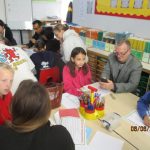Welcome back! Hope you all had a restful break with your families.
Let us start by thanking you all for coming to our Learning Together Morning. Once again, it was very successful and it’s apparent that children love sharing their work and knowledge with you. Thank you for sharing your favourite books with them, discussing about the characters and jointly writing book reviews.
This week, children gained a better understanding on empathy, throughout various activities. Empathy is the ability to understand and share the feelings of others. Excitedly, they made their own superpower glasses, so they can see things from other people’s points of view and understand their feelings.
This week, in English, we wrote our memories and achievements from Maple class as well as our goals and aspirations for next year. As always, we made fantastic vocabulary voices, used fronted adverbials and conjunctions to build cohesion. We then typed our work, ready to show it to you later in the term. So many beautiful memories, so many achievements. We are all proud of their effort.
In our first Geography lesson, children worked with a partner or in small groups and were given a set of Jigsaw Cards. Children were challenged to work on their team skills and race to put the jigsaw together to reveal a picture of the River Nile as seen from space. Children then shared what they already know about the River Nile and worked on ‘true or false’ statements.
In our science lessons this half term, we are focusing on changes in human development. In this week’s lesson, the children learned about the gestation period in humans and compared it to that of other animals. We examined the development from cells to an embryo and then to a foetus in humans. Mrs Martin shared her son’s scans from when he was a foetus at 12 weeks and then at 20 weeks. We observed the length of the foetus and how much it had developed from 12 to 20 weeks.
The children then explored the gestation periods of various animals and sorted them into categories of their choice. Many chose to categorise the animals by gestation times, from shortest to longest. They were not particularly surprised that a rat and a hamster shared similar gestation times, but they were surprised to learn that a kangaroo also had a similar gestation period. We looked at the development of a joey, discovering how tiny it is when born and how it spends around 10 months in its mother’s pouch before becoming independent.
































